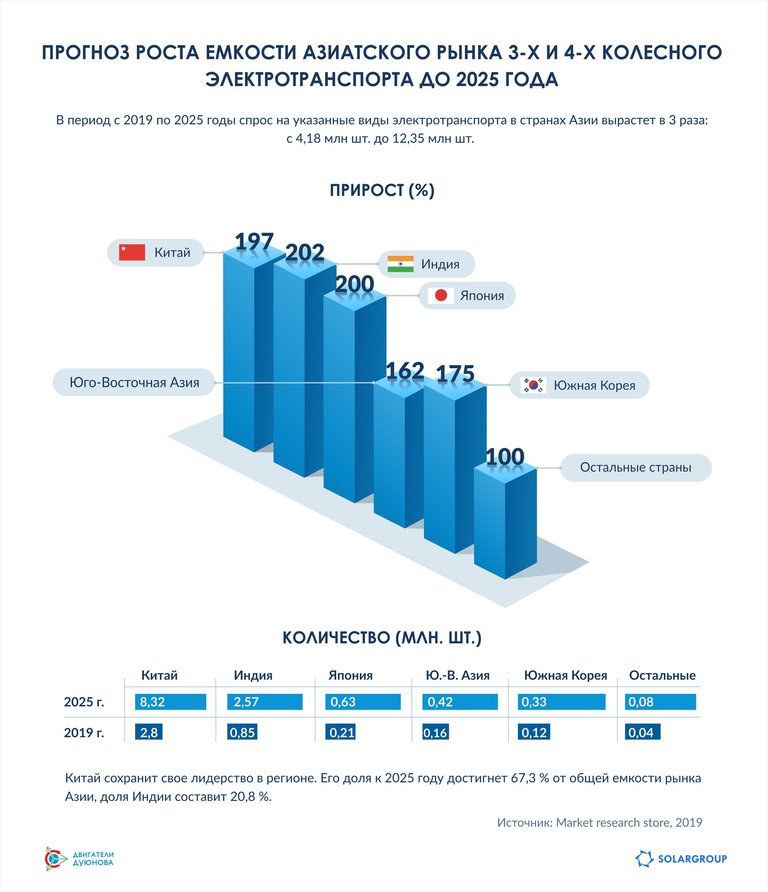Tuk-tuk or rickshaw is the most common type of motor transport in the countries of South and Southeast Asia. In large cities, gasoline 3-wheel and 4-wheel tuk-tuks are everywhere used as a taxi, purchased for personal movement and transportation of goods. This solution is ideal for poor, densely populated countries with a warm climate: economical fuel consumption (only 3 liters per 100 km) and small dimensions make tuk-tuks a widely accessible means of transportation.
According to data from Viktor Arestov, head of ASPP Weihai Technology, today millions of gas tuk-tuks travel on Asian roads: in India - 1.5 million units, in Sri Lanka - 1.2 million units. and at least 35 thousand units in Thailand. Dozens of local automakers annually release new models to meet the needs of the domestic market.
Due to the use of hundreds of thousands of gasoline engines, the air in major Asian cities is very polluted, which is why the environmental problem is urgently raised by the government of these countries. Manufacturers are looking for new solutions that will allow vehicles to maintain their low cost and minimize harmful effects on the environment.
The specificity of the operation of tuk-tuk is that they travel a short distance with the passenger, and then they stand in the sun, waiting for the next order. This time can be used to recharge vehicles from solar panels between flights.
The design and production of a new generation of innovative solar tuk-tuk is done by Viktor Arestov, a partner of the Duyunov Engines project. Hybrid rickshaw models that work on energy-efficient electric motors with Slavyanka and are additionally powered by solar panels have every chance of becoming extremely popular in Asia.
The tests of the first developments were relatively recent and received the ardent support of the Chinese government of the Weihai region. What is interesting about the potential cooperation for the Duyunov Engines project?
According to the forecasts of the marketing agency Market research store, the market for 3- and 4-wheel electric vehicles in Asia will increase by an average of 20% annually. Given its millionth capacity, the growth rate will mean an increase in production by 1-2 million units every year.
The markets of China and India are the largest in the region: today their need for electric tuk-tuk is 2.8 million. and 0.85 million pcs. respectively. By 2025, their total volume will triple, to 11 million. By concluding contracts with the government of these countries, you can get a virtually inexhaustible stream of orders and earn huge amounts!
For the Slavyanka technology and the Duyunov Engines project, the receipt of the first government order will mean global recognition of the effectiveness of Dmitry Duyunov’s invention.
Website: https://lp.solargroup.pro/atb260/979
Become an investor: https://lp.solargroup.pro/atb260/979
Instagram: https://www.instagram.com/avlion82/? H ...
YouTube Channel: https://goo.gl/bAMNhB
VK: https://vk.com/asynmotors

Congratulations @avlion! You have completed the following achievement on the Steem blockchain and have been rewarded with new badge(s) :
You can view your badges on your Steem Board and compare to others on the Steem Ranking
If you no longer want to receive notifications, reply to this comment with the word
STOPTo support your work, I also upvoted your post!
Do not miss the last post from @steemitboard:
Vote for @Steemitboard as a witness to get one more award and increased upvotes!